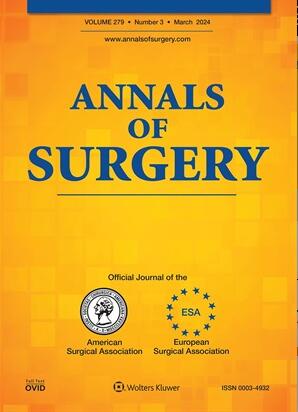535例先天性间母细胞肾瘤的临床和病理特征:来自儿童肿瘤组的报告。
IF 6.4
1区 医学
Q1 SURGERY
引用次数: 0
摘要
目的探讨儿童肿瘤组AREN03B2研究和CMN患者历史队列中先天性间母细胞肾瘤(CMN)患儿的临床病理特征。背景cmn是一种婴儿期的儿童肾肿瘤,其组织学亚型有细胞型、混合型和经典型。鉴于其罕见性,尚无循证临床实践指南。我们收集了2个大型CMN患儿队列的临床病理结果和结局数据。方法从2004-2019年,6412名患者入组AREN03B2,并对病理资料、影像学研究和手术报告进行前瞻性中心回顾。对CMNs进行识别和分类。从1973-2001年病理审稿人收集的CMNs历史队列中提取了类似的数据。结果共纳入535例儿童(139例来自AREN03B2;396人(来自历史队列)。在ARE03B2队列中,137例患者有可用的随访数据(中位随访时间:4.5年)。10例患儿复发(7.2%),4/10患儿病死。55名局部II期细胞性或混合性CMNs患儿中有4名(7.3%)复发,6/37(16.2%)局部III期细胞性或混合性CMNs患儿复发。局部I期或经典CMNs(任何阶段)患儿均无复发。所有复发发生在诊断后1.5年内,4/10复发发生在3个月内。在历史队列中,31名儿童(7.8%)复发;所有复发均为局部II期或III期细胞性或混合性复发。结论:虽然复发并不常见,但其与细胞或混合组织学亚型和分期高度相关,为指导治疗和监测提供了关键的临床信息。本文章由计算机程序翻译,如有差异,请以英文原文为准。
Clinical and Pathologic features of 535 Patients with Congenital Mesoblastic Nephroma: A Report from the Children's Oncology Group.
OBJECTIVE
To explore clinicopathologic features of children with congenital mesoblastic nephroma (CMN) enrolled on Children's Oncology Group study AREN03B2 and a historical cohort of CMN patients.
BACKGROUND
CMN is a pediatric renal tumor of infancy, with histologic subtypes of cellular, mixed, and classic. Given its rarity, evidence-based clinical practice guidelines are unavailable. We collected clinicopathologic findings and outcomes data in 2 large cohorts of children with CMN.
METHODS
From 2004-2019, 6412 patients enrolled in AREN03B2 and underwent prospective central review of pathology materials, imaging studies, and operative reports. CMNs were identified and subclassified. Similar data was extracted from a historical cohort of CMNs collected by pathology reviewers between 1973-2001.
RESULTS
In total, 535 children were included (139 from AREN03B2; 396 from the historical cohort). In the ARE03B2 cohort, 137 had available follow-up data (median follow-up: 4.5 y). Ten children (7.2%) relapsed, and 4/10 children died of disease. Four of 55 (7.3%) children with local stage II cellular or mixed CMNs relapsed, and 6/37 (16.2%) children with local stage III cellular or mixed CMNs relapsed. No child with local stage I or classic CMNs (of any stage) relapsed. All relapses occurred within 1.5 years of diagnosis, and 4/10 relapses occurred within 3 months. In the historical cohort, 31 children (7.8%) relapsed; all relapses were local stage II or III cellular or mixed.
CONCLUSIONS
While recurrences are uncommon, they are highly associated with cellular or mixed histologic subtypes and stage, providing key clinical information that may guide consideration of therapy and surveillance.
求助全文
通过发布文献求助,成功后即可免费获取论文全文。
去求助
来源期刊

Annals of surgery
医学-外科
CiteScore
14.40
自引率
4.40%
发文量
687
审稿时长
4 months
期刊介绍:
The Annals of Surgery is a renowned surgery journal, recognized globally for its extensive scholarly references. It serves as a valuable resource for the international medical community by disseminating knowledge regarding important developments in surgical science and practice. Surgeons regularly turn to the Annals of Surgery to stay updated on innovative practices and techniques. The journal also offers special editorial features such as "Advances in Surgical Technique," offering timely coverage of ongoing clinical issues. Additionally, the journal publishes monthly review articles that address the latest concerns in surgical practice.
 求助内容:
求助内容: 应助结果提醒方式:
应助结果提醒方式:


